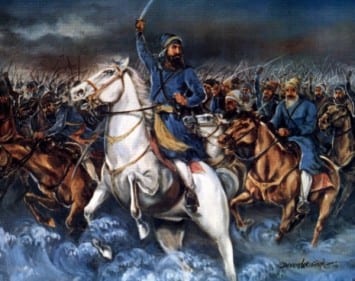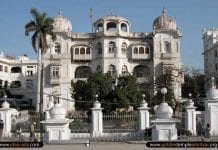I think I’ve finally found a religion I can convert to. I’m thinking of turning Sikh. And we’ll just slide right by all the puns popping into your little heads, if you don’t mind. The Sikhs are just the coolest warrior tribe around. Take their scripture.
It all started when I got a letter from a guy named Gill, a Sikh in the UK, whining about how I’d talked up all the other warrior tribes but never had a word to say for the Sikhs. “Give us some love, Gary,” Gill whined.
Well, the War Nerd makes war, not love, but after weeks of looking into this Sikh thing, I gotta give the bearded boys their due. The Sikhs have one of the most amazing military histories on the planet. And they’re still living through their Golden Age right now. One of the great last stands in Sikh history happened less than 25 years ago, when 200 Sikh militants holed up in their version of the Mormon Tabernacle, the “Golden Temple” in Amritsar, India. Anybody with sense knew those 200 Sikhs were going to fight like demons, because that’s what Sikhs have been doing for the past 400 years. Sikh military history is so packed with glorious last stands that George Armstrong Custer would be a smalltime footnote if he’d worn a big turban to go with that long hair and beard of his.
It was 1984, and the Indian Army must have known it was in for a big bloody mess to get the temple back, especially since its upper ranks are filled mostly with Sikh generals, Sikhs being the designated hitters of the Indian war game. But Indira Gandhi was PM, and she was a lady who didn’t like being disobeyed, so she ordered her Sikh Commanding General to overrun the temple.
Mistake. The Sikh CO inside the temple was a dude named Shahbeg Singh, who pretty much single-handedly engineered the collapse of the Pakistani Army in the 1971 Indo-Pak War. It was Shahbeg who organized the Mukhti Bahini, the Bangladeshi guerrillas who made history by being the first Bengali armed force in history not to pee in their dhotis and flee at the sound of gunfire. In fact, this Sikh must’ve given the Bengalis some kind of Sikh blood transfusion because they fought well enough to make the West Pak garrisons surrender en masse even before Indian troops crossed the Bengal border. After that it was the end of history for East Bengal, except for a bunch of whiney George Harrison begging chanteys, and a tidal wave or two.
Well, this same Shahbeg arranged the defense of the Golden Temple so well that at the end of a seven-day battle with the Indian Army’s best units, his 200-odd amateur militants had inflicted 83 KIA on the army and even managed to blast the first tank to enter the compound. They paid a price, naturally – at least 500 Sikh dead. But Sikhs — well, if there’s one thing you can say about ‘em, it’s that they’re willing to pay any price.
And they make the enemy pay, too. Less than five months after Indira Gandhi ordered the attack on the Temple, she was strolling into her garden to be interviewed by that fat old Brit with the Russian name, Peter Ustinov, when the Sikhs got their revenge. It must have been a pretty scene, the fat man sweating in the Delhi heat, Indira swirling up in her best sari — when BOOM! Two of her bodyguards, who were Sikhs, naturally, opened fire on her with machine guns, turning her into human chutney. She died before the sweat dried on Ustinov’s chins. And then, just to add to Ustinov’s fun, her other non-Sikh bodyguards started blasting at the Sikh shooters, killing one and wounding another.
Shortest — and loudest — interview the old battle-ax ever gave. Last, too.
That was the Sikh revenge for “Operation Bluestar,” the temple raid. By the way, that’s another of these lame ops titles they keep coming up with. Should’ve called it “Operation Blowback,” or “Operation Indira, Are You Sure?”
For the Sikhs, this was just like Chapter Two Million in a long and glorious series of battles, assassinations and massacres. The Sikhs were born in the Punjab, the coolest part of India. Every conqueror in history headed that way as soon as he got his learner’s license at 15. Punjab was the last, and the toughest place Alexander himself ever tried to take. He was so impressed with the army of Pontus, as they called it then, that he said every Punjabi deserved to be called Alexander. Which was high praise, since Alex was never known for modesty.
Before him even those lazy necrophiliac Egyptians had a stab at the Punjab. I couldn’t believe it when I read it, but apparently those Nile-side loungers had the energy to attack the Punjab. Everybody had a turn, though it was the Persians and the Afghans who turned invading the Punjab from a healthy, occasional fun evening into an unhealthy obsession.
And that was before Islam was added to the subcontinental mix. By the time Sikhism started, about 400 years ago, the Mughal emperors, basically a bunch of land pirates who swooped down out of Afghanistan to plunder the plains, had tried to convert India to Islam by using the time-honored method of appealing to the prospect’s common sense: “Convert or we’ll hack you into a million tiny pieces.” The Hindu majority, under the thumbs of hundreds of feudal kings, tried to weasel out of conversion so they could hang on to their own homegrown miseries, like the caste system. The Hindus’ ultimate weapon was simple inertia and birthrate. The Afghans’ sword arms just got tired after a while, hacking in that heat, and they said, “Aw, the Hell with it.” Northern India settled into a lazy routine with the occasional massacre, a lot of bribery, nasty little village snobs hating each other.
Then along comes the founder of Sikhism, Nanak, and says, “There is no Muslim, there is no Hindu.” Meaning the Hell with both of you. Sikhs were radicals from the start. All the little traditions people know about them started out as in-your-face rebel yells in the Punjab. Like those beards: only the Mughal were allowed to wear long hair and beards. So the Sikh all let theirs grow longer than John and Yoko’s. That name, “Singh,” every Sikh guy has? It means “Lion” but the real point is that it replaced all the caste names they had before. Like Malcolm making his last name “X.”
The Sikhs’ real weapon was the flintlock. A grumbly Muslim Afghan wrote that “these dogs [the Sikhs] invented the musket, and nobody knows these weapons better. These bad-tempered people discharge hundreds of bullets on the enemy, on the left and right and back.” Aww, poor little Afghan! Those pesky bad-tempered Sikhs, shooting at you when all you want to do is massacre them for their unbelief and steal their stuff along the way! No-friggin’-fair!
The Sikhs were more than happy to fight hand-to-hand whenever it made sense, and even got praise from the Brits for hacking Brit soldiers to death with their swords even after being spitted on the redcoats’ bayonets. But the Sikhs were also sensible people: Why risk getting cut when you can lure the enemy into an ambush and knock him out of the saddle at long range?
The Sikhs evolved a theory of warfare called “the two-and-a-half strikes.” You got a full point for ambushes and hit-and-run attacks, but only a half point for pitched battles where you lost a lot of your own men. Nathan Bedford Forrest, Francis Marion and Patton himself would have agreed.
By 1810 the Sikhs had driven the Mughals out of the Punjab. They owned the place, literally: They had an independent Sikh kingdom running there, and by all accounts it was the one place in India where something sorta resembling law and order actually prevailed.
The only reason the Sikhs didn’t go on to run all of India and maybe the world is simple: They ran into the Brits. Same reason the Zulu didn’t get to own all of southern Africa. A lot of big, strong tribes were on the move in Queen Victoria’s time, and the same thing happened to most of them: They met the Brits, and that was all she wrote.
Ranjit Singh, the ruler of the Punjab, was smart enough to sign a treaty with the Brits, keep a strong army to back it up, and avoid the sort of little faked “border incidents” the Raj loved to use to start a war. When he died in 1839, the Punjab fell into the usual bickering, and the Brits pounced.
I keep telling you, the Brits circa 1840 weren’t the cute little Monty Python guys you imagine. They were stone killers, the best since the Romans, totally ruthless, no more conscience than a drain contractor. They saw the Sikhs fighting among themselves and went for it.
Even then, even with Sikh traitors fighting for the Brits, the Sikhs had the best of the first Anglo-Sikh war. The Brits lost more than 2,000 men in the first battle, Ferozeshah, in 1845, and were on the verge of offering unconditional surrender when reinforcements arrived and overwhelmed the Khalsa, the Sikh army. The second war, in 1849, was easier, because the Brits, who knew more about occupation than our lame Bremer clones ever will, used the three years in between to bribe, assassinate and divide the Sikh elite. Even so, the Sikh cavalry, fighting basically without any leaders, slaughtered the British cavalry at the battle of Chillianwalla, smacking down the redcoats’ little ceremonial swords with their big scimitars. I’ve read Brit officers’ accounts of that battle, and they say something you get in all accounts of the Sikh: how big and strong the bastards are. The Brits said they felt like children beside the Sikh horsemen, and there’s really funny picture of a white officer surrounded by Sikh soldiers, looking like a pasty little midget with his bodyguards.
And you know the best thing about the Sikhs? They don’t waste time holding grudges. The Brits won; they accepted it, worked with it, and in a few years they were the core of the Raj’s army. That came in handy during the Great Mutiny; the Sikhs stayed loyal and that was what saved the Raj. In fact, the Sikhs stayed so loyal that the battle of Saraghari, one of their greatest-ever last stands, was fought in the service of the British.
In 1897, 21 Sikh soldiers in British service were occupying two tiny forts on the Afghan frontier. The Pushtun were getting bored, the way they do every few months, and decided to stop taking British gold and attack the Raj instead. So 15 or 20,000 Afghans whooped down to the frontier. And those 21 Sikhs were standing in their way.
The Sikh garrison knew they were doomed, and if anything it kind of relaxed them. They went on to cover themselves with glory, killing hundreds of Afghans before they were overrun. The unit’s communications specialist, who used a helicograph, a kind of semaphore, sent his last message asking permission of his Brit officer to stop signaling and go down and die spitting Afghans on his bayonet. Permission was granted, and he carefully packed up his helicograph, charged into the fight and died gloriously.
The only objection you could make, and it’s kind of a quibble, is that politically this is a little weird, like a bunch of Mexicans dying in defense of the Alamo. I mean, it was the Brits who wrecked the Sikh’s homeland and all. But see, that kind of nitpicking is what ruins war-nerding. If you ask me, the Sikhs who died at Saraghari were just doing what they do best. I mean, what boy didn’t dream of dying at the Alamo, or Thermopylae, or on the Bonhomme Richard? Not many of us get a chance to actually do it, and if you do, you don’t nitpick about who pays your wages, you just soak up the gloriousness of it and imagine the songs they’ll write about you, how you’ll look as a statue.
And that’s the great thing about being a Sikh, which I’m gonna be soon unless the beard turns out too scratchy: It’s still happening! The Golden Age of Sikhism is still in session! When the rest of the world is a convalescent home, you can count on the Punjab – along with the Horn of Africa, and the Congo — to keep the old ways going. And you can count on the Sikh to be there, doing a Little Big Horn or Alamo every few years to keep life sweet, and give me hope that there’s something better outside of this office life I’m stuck in.






I really enjoyed reading the article because of its humour and wit. But I agree with DJ. Sikhs really need to dump this warrior stuff. It is getting in the way of our need to preach our (REAL) religion, about the Dharma, not about fighting and winning wars. What has that got to do with any kind of religion anyway? It was great in the past and got us here. But today it is irrelevant and will not generate any interest from anyone outside the Punjabi community. You can’t market the Sikh religion at all to anyone talking about bravado and courage, and how brave Sikhs are. That is for nations and armies. It has nothing to do with the peace of mind and salvation that the world is hungering for.
Gary Brecher pays us a wonderful tribute and we are really grateful for that. But I rather wish that the reason for ‘converting’ had been for the fact that Sikhi is the only religion in the world today that has any chance of saving mankind from themselves. The ‘Fatherhood of God, Brotherhood of Man’ preached by our Holy Guru Nanak, the presence of the names of God from other religions in our Holy Scripture, the divine songs of masters from all religions, Sikh, Hindu, Muslim……now that would be something to ‘convert’ for…..and invite the rest of the world to follow!
If mankind ever survives the Third World War, the Sikh religion will be the only means of uniting and guiding them. So said Bertrand Russel. British Philosopher and Free Thinker. 1872 – 1970
This hardly a “praise” , nor is it from a credible/mainstream publication.
Who needs such “warrior” skills anyway? The world now runs on collaborative and creative skills – do you have any articles that praise the Sikhs for such skills? (Example : Sikhs volunteer to construct a bridge in India..etc.)
when millions of people can eat langar sitting together irrespective of caste, creed. Des anyone have better example than that. When thousands of non-sikh sisters and mothers
were saved and brought back form abdalli and other conquerers, were you consider a bridge inspire of that ?
Sikhs are not merely excellent warriors but are spiritual socialists who believe in Parenthood of one God,Universal brotherhood,honest livelihood,sharing surplus resources with needy irrespective of their caste or creed and meditation on timeless God who is infinite and never takes birth.For becoming truthful as God is Ultimate Reality or Truth, they practice utmost submission to the will of God and that is why they keep long hair.Their scripture has Hymns of saints of other religions also.they believe in human rights of all people and their 9th guru sacrificed his life to protect the right of Hindus to follow their own religion although he did not follow their practices.
DJ Singh,
Just because the magazine isn’t mainstream, that doesn’t make it’s message any less: that Sikhs courageous and will fight to the end even against overwhelming odds and certain death to uphold their values.
It’s with that courage that 42 Sikhs fought against the Mughal Army which numbered over 100,000+ and still were still victorious with Guru Ji escaping along with countless other battles in our history. The fact that Sikhs are willing to stand up against oppression is the reason why Sikhism is still exists today. If it weren’t for that, Sikhism would have diminished in India just like Buddhism, Jainism and other indigenous cultures.
At the very least, every Sikh (and every human being, for that matter) should be able to defend himself and his immediate family. That’s where some warrior skills are needed and will always be required. If you think the government will do that for you, you’re a fool.
As per Sikhs volunteering to construct a bridge in India, Sikh don’t owe India anything and have disproportionately made greater contributions to India than any other community. If it weren’t for Sikhs, you would probably be a Muslim convert via Mughal Empire and India would still be under British rule.
As per the BBC, Sikhs are the most charitable of all communities. In our religion, we have the concept of ‘Seva’ and Sikhs have helped in many humanitarian crises around the world (Haiti earthquake, etc.) without any missionary objectives like other religions.
Are you sure you’re a Sikh? You sound more like a jealous Hindu.